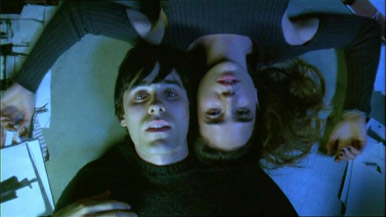Are You With Us? Requiem for a Dream
By Shalimar Sahota
October 8, 2009
The overall look of just about everything is dirty and grimy. Even Sara's visit to her doctor, a place you'd expect to have the highest hygiene standards, looks like it's never been cleaned before. Even when Sara has cleaned her own apartment it doesn't look like she's made a huge difference. As well as drab colours, Aronofsky also incorporates an unusual choice of very technical shots. Split-screen and a SnorriCam (facing the actor directly during their movements) are used extensively. There's a birds-eye view when Sara posts her letter and a few time-lapsed shots like when Sara is cleaning her apartment. Sure the visual style enhances the effect, disorienting the viewer, but at times it can feel rather unnecessarily pretentious too.
Aronofsky has his usual collaborators, such as cinematographer Matthew Libatique and mainly actors Mark Margolis, Sean Gullette, Samia Shoaib and Ajay Naidu, who frequently crop up in his films. The most notable is composer Clint Mansell, who has worked on all of Aronofsky's films. His score here is exemplary, with its mix of techno beats and orchestral strings, and string quartets performed by Kronos Quartet. Lux Aeterna is the obvious standout here with the track and its variations now frequently used in trailers (effectively for Lord of the Rings: The Two Towers), TV shows and many a You Tube video to make them more epic than they have any right to be. Screeching strings make the final act unbearably horrendous. In surround sound some moments border upon the frightening with some interesting sound effects. Those of you with a decent home cinema set-up will hear the scariest fridge since The Refrigerator coming a mile off.
The film was slapped with an NC-17 rating because of a sex scene (there are R-rated films that have gotten away with more). Aronofsky appealed, but the MPAA refused to budge. Unusually, distributors Artisan did something that rarely happens today; they respected Aronofsky's wishes and released it uncut. The rating should give an indication of its box office takings. With a production budget of $4.5 million, it originally opened on just two screens, but a steady increase and a lengthy 22-week run allowed it to earn $3.6 million at the US box office.
Aronofsky went on to direct The Fountain, which was more about extending life rather than the destruction of it, and achieved close to mainstream success with Mickey Rourke in The Wrestler. One could say that the themes of addiction and even greed are prevalent in all of Aronofsky's films. Driven mad trying to solve a mathematical equation for possible gain in the stock market in p, searching endlessly through three lifetimes for eternal life in The Fountain and knowing when to quit but refusing to do so in The Wrestler.
Clearly a powerful film, you're not watching this to be entertained. Requiem for a Dream shows that no matter how good the rush may be at the time, the side effects will always be worse and ultimately everyone loses something. What we really need to know is if it's become required viewing in rehab clinics.
If you too would like to see someone shooting up into a gangrenous vein in glorious high definition then the Lionsgate region-free blu-ray is available for less than $10 on Amazon.com, and has been for a very long time now.
Continued:
1
2
|
|
|
|




